ISUZU KB P190 2007 Workshop Manual PDF
Manufacturer: ISUZU, Model Year: 2007, Model line: KB P190, Model: ISUZU KB P190 2007Pages: 6020, PDF Size: 70.23 MB
Page 71 of 6020
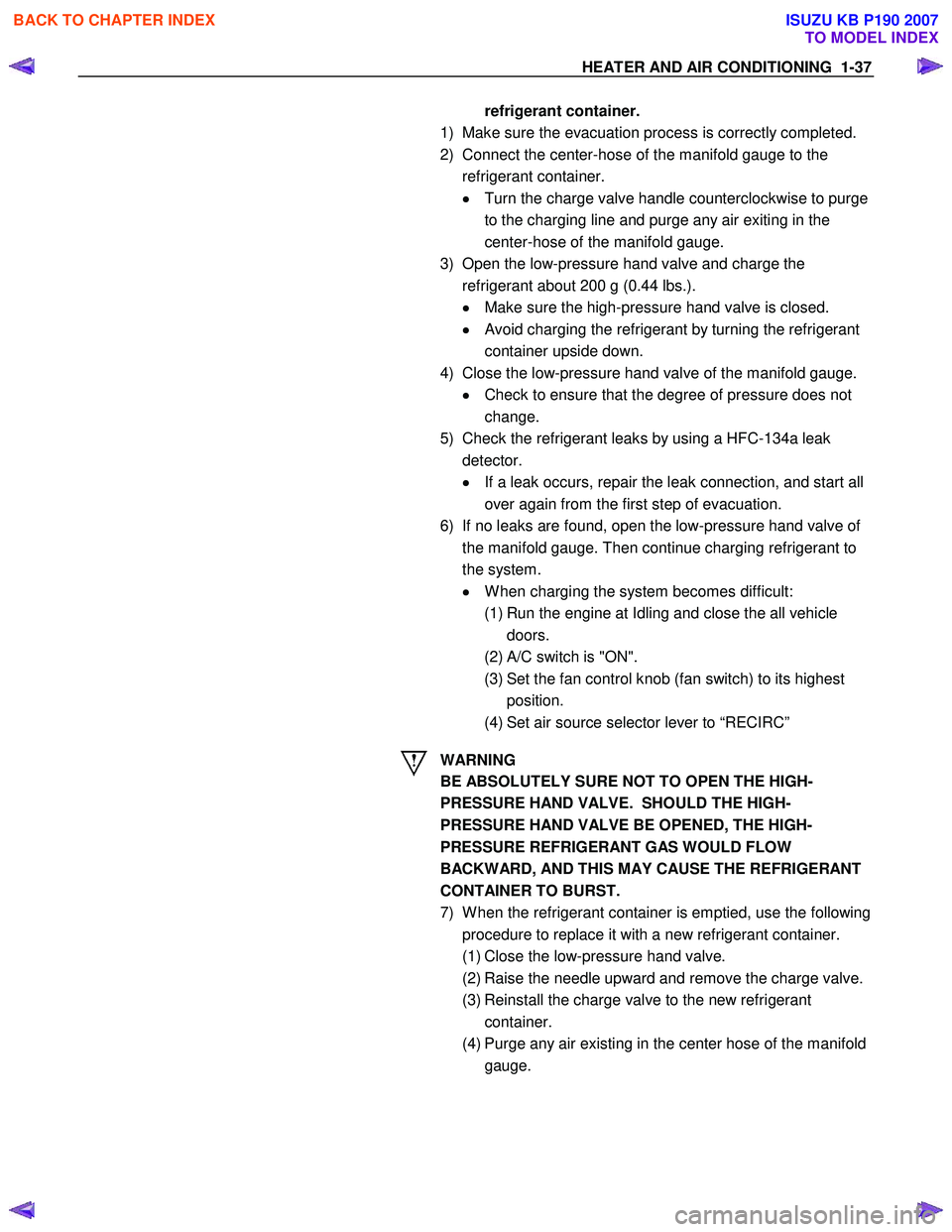
HEATER AND AIR CONDITIONING 1-37
refrigerant container.
1) Make sure the evacuation process is correctly completed.
2) Connect the center-hose of the manifold gauge to the refrigerant container. •
••
•
Turn the charge valve handle counterclockwise to purge
to the charging line and purge any air exiting in the
center-hose of the manifold gauge.
3) Open the low-pressure hand valve and charge the refrigerant about 200 g (0.44 lbs.). •
••
•
Make sure the high-pressure hand valve is closed.
•
••
•
Avoid charging the refrigerant by turning the refrigerant
container upside down.
4) Close the low-pressure hand valve of the manifold gauge. •
••
•
Check to ensure that the degree of pressure does not
change.
5) Check the refrigerant leaks by using a HFC-134a leak detector. •
••
•
If a leak occurs, repair the leak connection, and start all
over again from the first step of evacuation.
6) If no leaks are found, open the low-pressure hand valve of the manifold gauge. Then continue charging refrigerant to
the system. •
••
•
W hen charging the system becomes difficult:
(1) Run the engine at Idling and close the all vehicle doors.
(2) A/C switch is "ON".
(3) Set the fan control knob (fan switch) to its highest position.
(4) Set air source selector lever to “RECIRC”
WARNING
BE ABSOLUTELY SURE NOT TO OPEN THE HIGH-
PRESSURE HAND VALVE. SHOULD THE HIGH-
PRESSURE HAND VALVE BE OPENED, THE HIGH-
PRESSURE REFRIGERANT GAS WOULD FLOW
BACKWARD, AND THIS MAY CAUSE THE REFRIGERANT
CONTAINER TO BURST.
7) W hen the refrigerant container is emptied, use the following procedure to replace it with a new refrigerant container.
(1) Close the low-pressure hand valve.
(2) Raise the needle upward and remove the charge valve.
(3) Reinstall the charge valve to the new refrigerant container.
(4) Purge any air existing in the center hose of the manifold gauge.
BACK TO CHAPTER INDEX
TO MODEL INDEX
ISUZU KB P190 2007
Page 72 of 6020
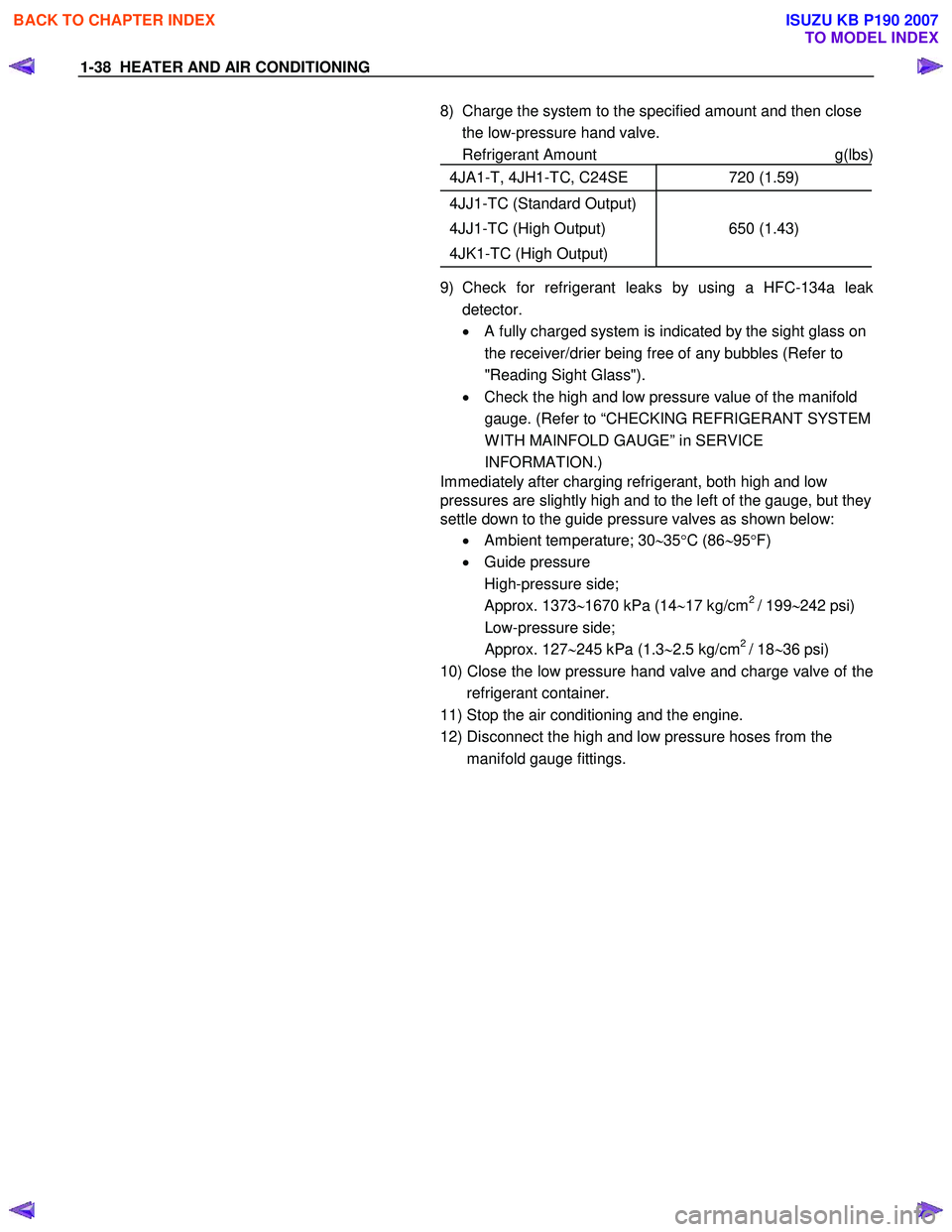
1-38 HEATER AND AIR CONDITIONING
8) Charge the system to the specified amount and then close the low-pressure hand valve.
Refrigerant Amount g(lbs)
4JA1-T, 4JH1-TC, C24SE 720 (1.59)
4JJ1-TC (Standard Output)
4JJ1-TC (High Output)
4JK1-TC (High Output)
650 (1.43)
9) Check for refrigerant leaks by using a HFC-134a leak detector.
• A fully charged system is indicated by the sight glass on
the receiver/drier being free of any bubbles (Refer to
"Reading Sight Glass").
• Check the high and low pressure value of the manifold
gauge. (Refer to “CHECKING REFRIGERANT SYSTEM
W ITH MAINFOLD GAUGE” in SERVICE
INFORMATION.)
Immediately after charging refrigerant, both high and low
pressures are slightly high and to the left of the gauge, but they
settle down to the guide pressure valves as shown below:
• Ambient temperature; 30 ∼35 °C (86 ∼95 °F)
• Guide pressure
High-pressure side;
Approx. 1373 ∼1670 kPa (14 ∼17 kg/cm
2 / 199 ∼242 psi)
Low-pressure side;
Approx. 127 ∼245 kPa (1.3 ∼2.5 kg/cm
2 / 18 ∼36 psi)
10) Close the low pressure hand valve and charge valve of the refrigerant container.
11) Stop the air conditioning and the engine.
12) Disconnect the high and low pressure hoses from the manifold gauge fittings.
BACK TO CHAPTER INDEX
TO MODEL INDEX
ISUZU KB P190 2007
Page 73 of 6020
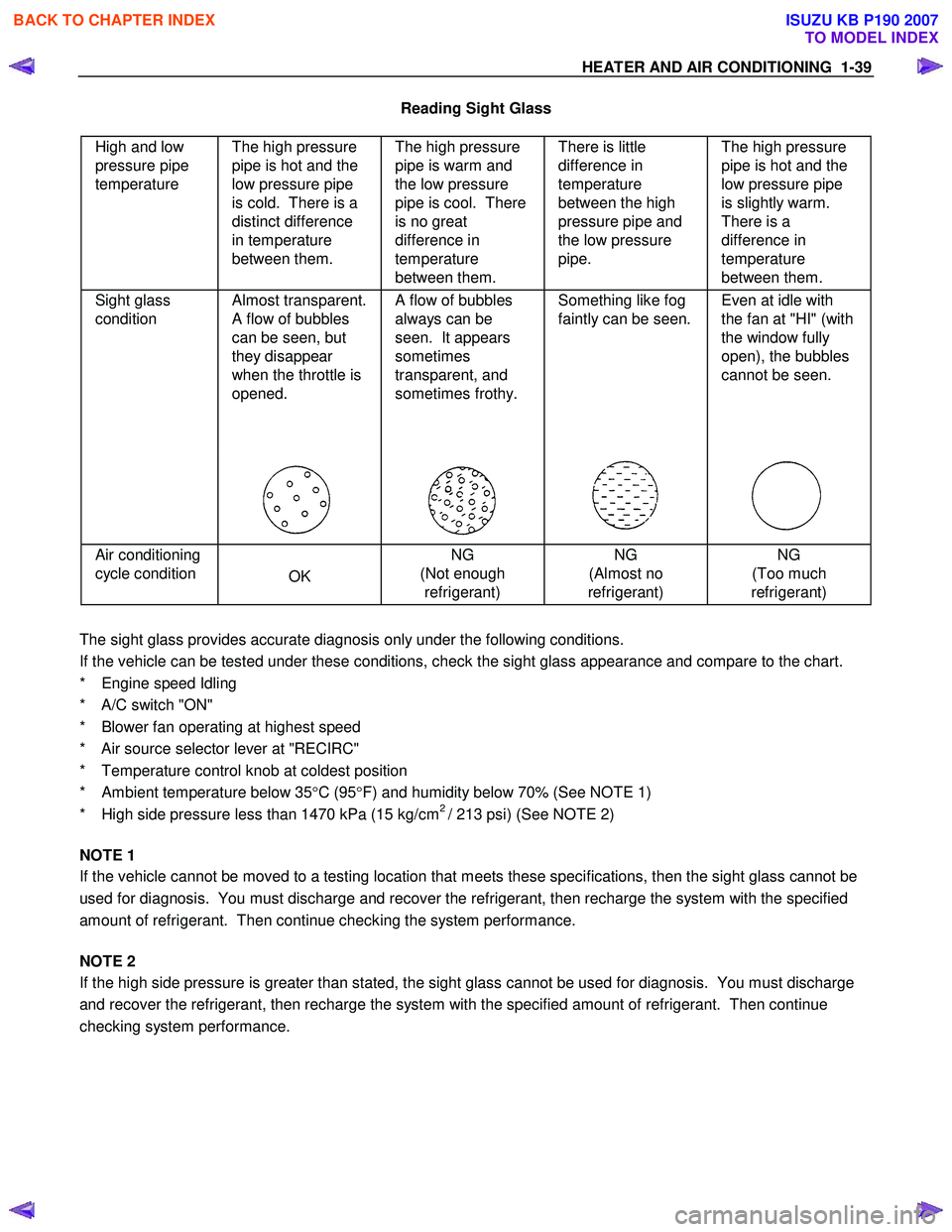
HEATER AND AIR CONDITIONING 1-39
Reading Sight Glass
High and low
pressure pipe
temperature The high pressure
pipe is hot and the
low pressure pipe
is cold. There is a
distinct difference
in temperature
between them. The high pressure
pipe is warm and
the low pressure
pipe is cool. There
is no great
difference in
temperature
between them. There is little
difference in
temperature
between the high
pressure pipe and
the low pressure
pipe. The high pressure
pipe is hot and the
low pressure pipe
is slightly warm.
There is a
difference in
temperature
between them.
Sight glass
condition Almost transparent.
A flow of bubbles
can be seen, but
they disappear
when the throttle is
opened.
A flow of bubbles
always can be
seen. It appears
sometimes
transparent, and
sometimes frothy.
Something like fog
faintly can be seen.
Even at idle with
the fan at "HI" (with
the window fully
open), the bubbles
cannot be seen.
Air conditioning
cycle condition
OK NG
(Not enough refrigerant) NG
(Almost no
refrigerant) NG
(Too much
refrigerant)
The sight glass provides accurate diagnosis only under the following conditions.
If the vehicle can be tested under these conditions, check the sight glass appearance and compare to the chart.
* Engine speed Idling
* A/C switch "ON"
* Blower fan operating at highest speed
* Air source selector lever at "RECIRC"
* Temperature control knob at coldest position
* Ambient temperature below 35 °C (95 °F) and humidity below 70% (See NOTE 1)
* High side pressure less than 1470 kPa (15 kg/cm
2 / 213 psi) (See NOTE 2)
NOTE 1
If the vehicle cannot be moved to a testing location that meets these specifications, then the sight glass cannot be
used for diagnosis. You must discharge and recover the refrigerant, then recharge the system with the specified
amount of refrigerant. Then continue checking the system performance.
NOTE 2
If the high side pressure is greater than stated, the sight glass cannot be used for diagnosis. You must discharge
and recover the refrigerant, then recharge the system with the specified amount of refrigerant. Then continue
checking system performance.
BACK TO CHAPTER INDEX
TO MODEL INDEX
ISUZU KB P190 2007
Page 74 of 6020
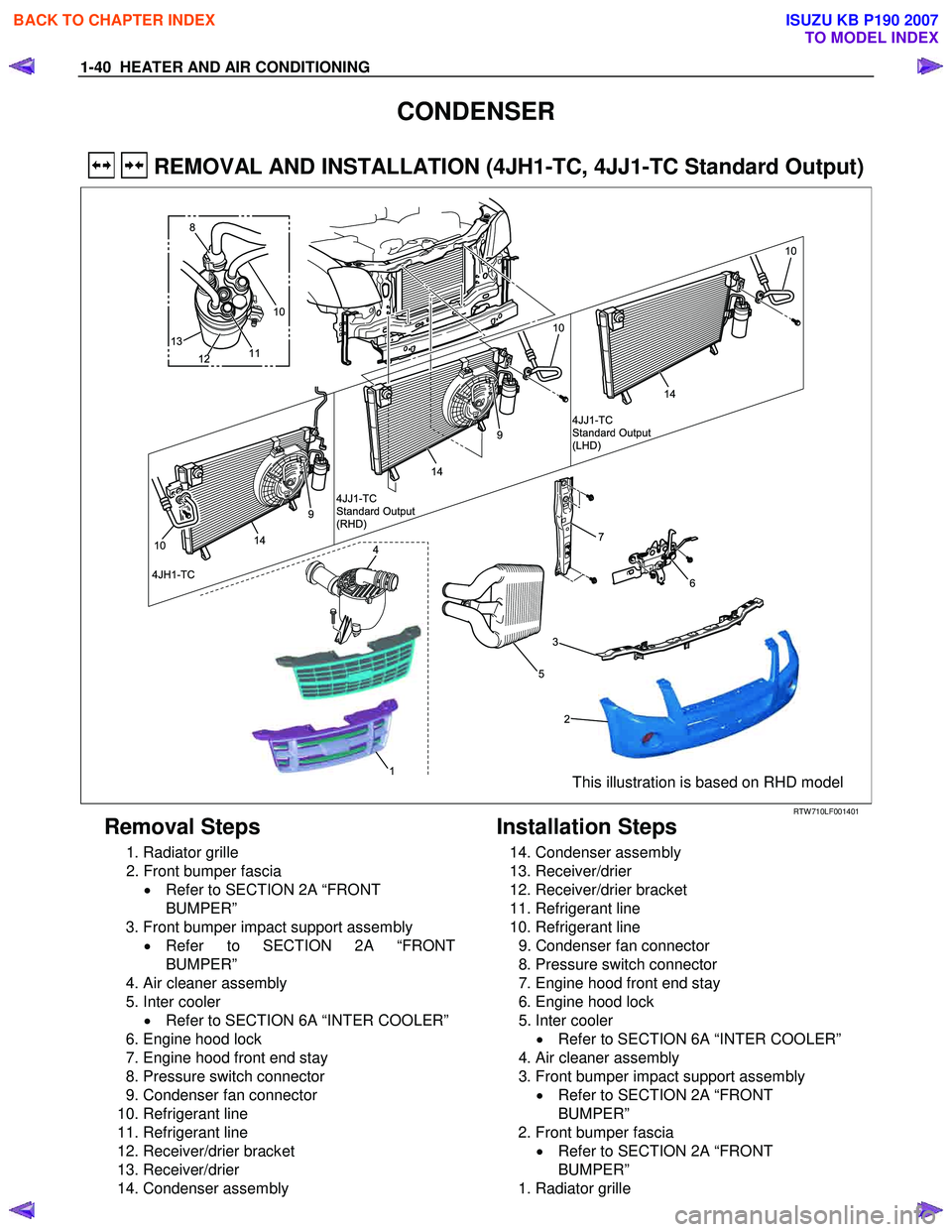
1-40 HEATER AND AIR CONDITIONING
CONDENSER
REMOVAL AND INSTALLATION (4JH1-TC, 4JJ1-TC Standard Output)
13
12
8
10
11
14
10
9
6
7
5
2
3
1
41410
4JH1-TC 4JJ1-TC
Standard Output
(RHD)
14
10
4JJ1-TC
Standard Output
(LHD)
9
This illustration is based on RHD model
RTW 710LF001401
Removal Steps
1. Radiator grille
2. Front bumper fascia • Refer to SECTION 2A “FRONT
BUMPER”
3. Front bumper impact support assembly • Refer to SECTION 2A “FRONT
BUMPER”
4. Air cleaner assembly
5. Inter cooler • Refer to SECTION 6A “INTER COOLER”
6. Engine hood lock
7. Engine hood front end stay
8. Pressure switch connector
9. Condenser fan connector
10. Refrigerant line
11. Refrigerant line
12. Receiver/drier bracket
13. Receiver/drier
14. Condenser assembly
Installation Steps
14. Condenser assembly
13. Receiver/drier
12. Receiver/drier bracket
11. Refrigerant line
10. Refrigerant line
9. Condenser fan connector
8. Pressure switch connector
7. Engine hood front end stay
6. Engine hood lock
5. Inter cooler • Refer to SECTION 6A “INTER COOLER”
4. Air cleaner assembly
3. Front bumper impact support assembly • Refer to SECTION 2A “FRONT
BUMPER”
2. Front bumper fascia • Refer to SECTION 2A “FRONT
BUMPER”
1. Radiator grille
BACK TO CHAPTER INDEX
TO MODEL INDEX
ISUZU KB P190 2007
Page 75 of 6020
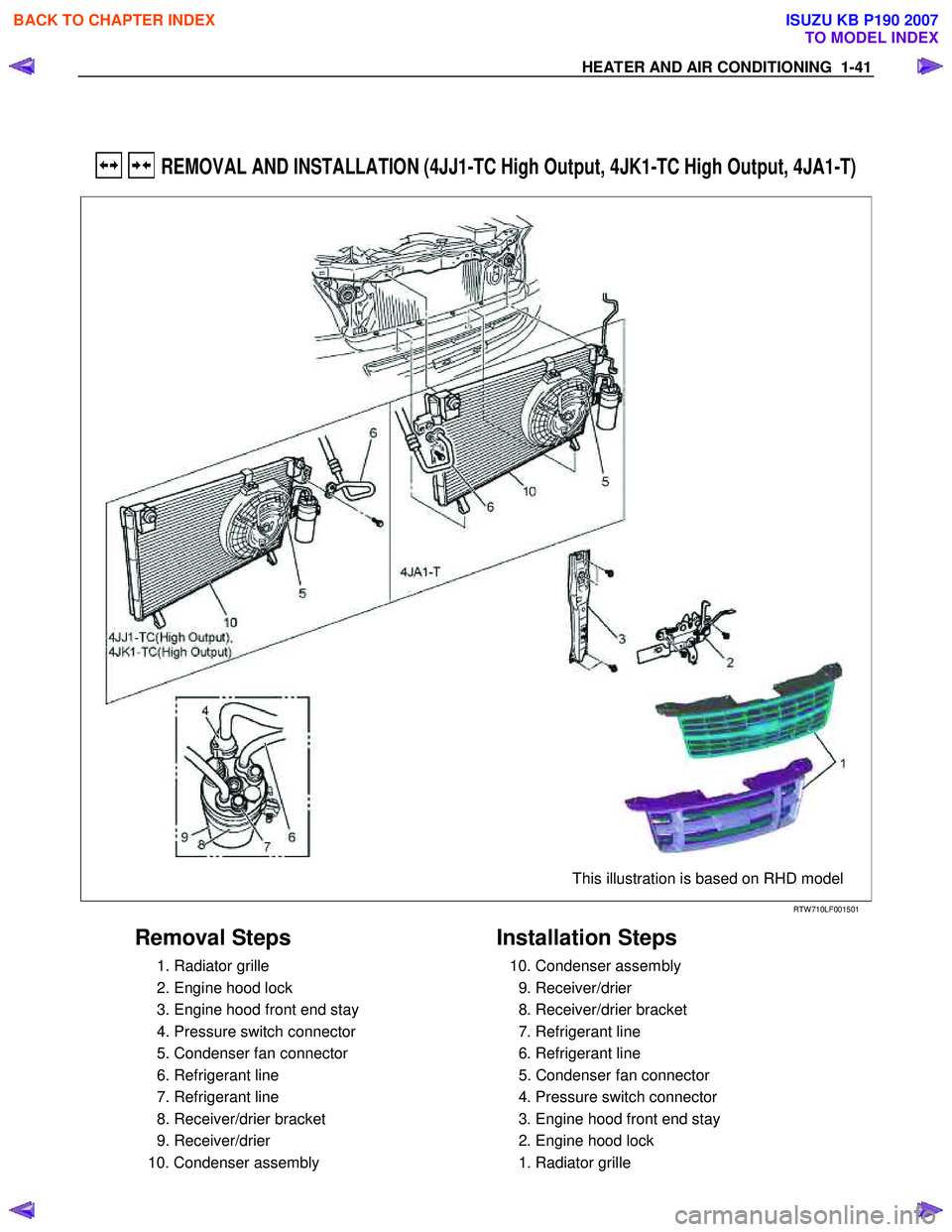
HEATER AND AIR CONDITIONING 1-41
REMOVAL AND INSTALLATION (4JJ1-TC High Output, 4JK1-TC High Output, 4JA1-T)
This illustration is based on RHD model
RTW 710LF001501
Removal Steps
1. Radiator grille
2. Engine hood lock
3. Engine hood front end stay
4. Pressure switch connector
5. Condenser fan connector
6. Refrigerant line
7. Refrigerant line
8. Receiver/drier bracket
9. Receiver/drier
10. Condenser assembly
Installation Steps
10. Condenser assembly
9. Receiver/drier
8. Receiver/drier bracket
7. Refrigerant line
6. Refrigerant line
5. Condenser fan connector
4. Pressure switch connector
3. Engine hood front end stay
2. Engine hood lock
1. Radiator grille
BACK TO CHAPTER INDEX
TO MODEL INDEX
ISUZU KB P190 2007
Page 76 of 6020
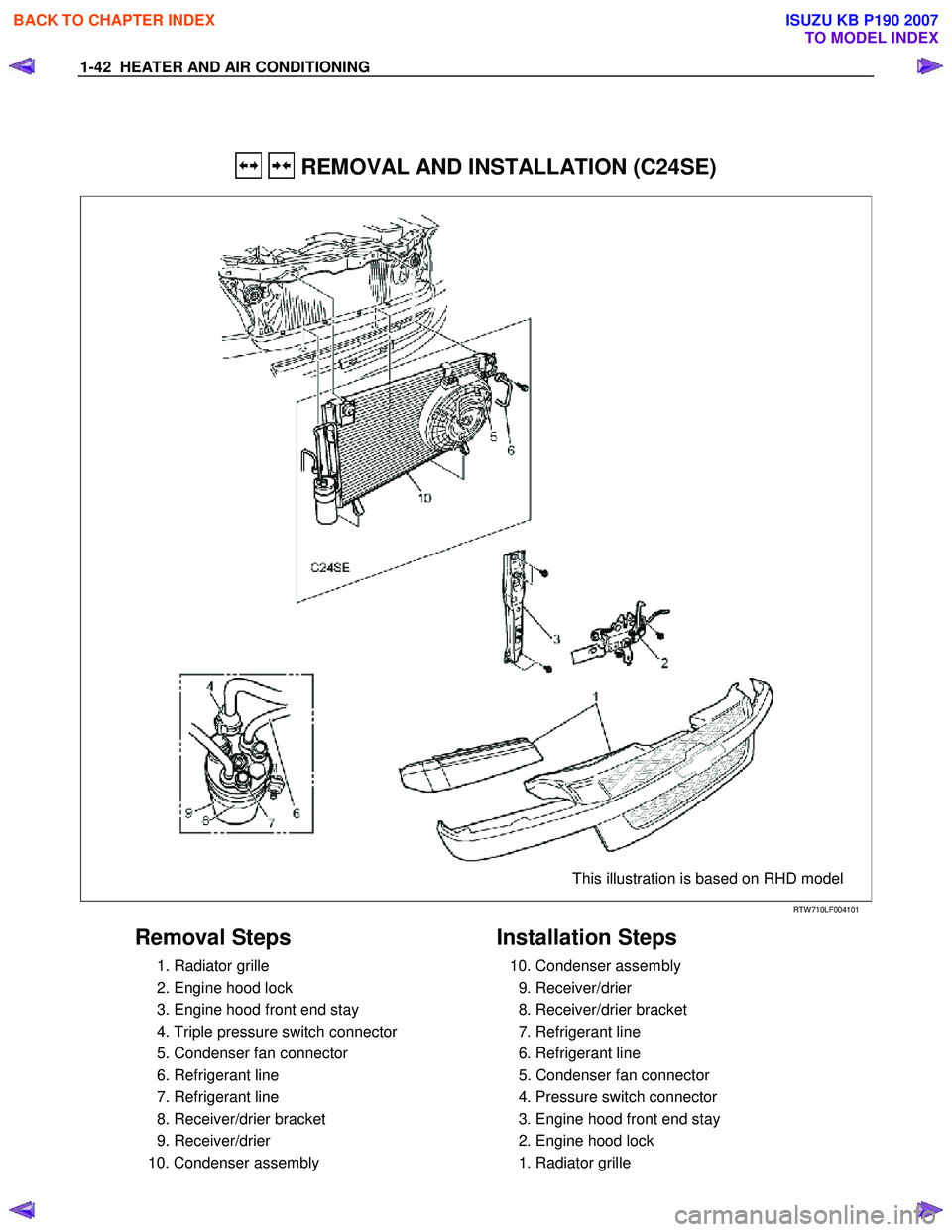
1-42 HEATER AND AIR CONDITIONING
REMOVAL AND INSTALLATION (C24SE)
This illustration is based on RHD model
RTW 710LF004101
Removal Steps
1. Radiator grille
2. Engine hood lock
3. Engine hood front end stay
4. Triple pressure switch connector
5. Condenser fan connector
6. Refrigerant line
7. Refrigerant line
8. Receiver/drier bracket
9. Receiver/drier
10. Condenser assembly
Installation Steps
10. Condenser assembly
9. Receiver/drier
8. Receiver/drier bracket
7. Refrigerant line
6. Refrigerant line
5. Condenser fan connector
4. Pressure switch connector
3. Engine hood front end stay
2. Engine hood lock
1. Radiator grille
BACK TO CHAPTER INDEX
TO MODEL INDEX
ISUZU KB P190 2007
Page 77 of 6020
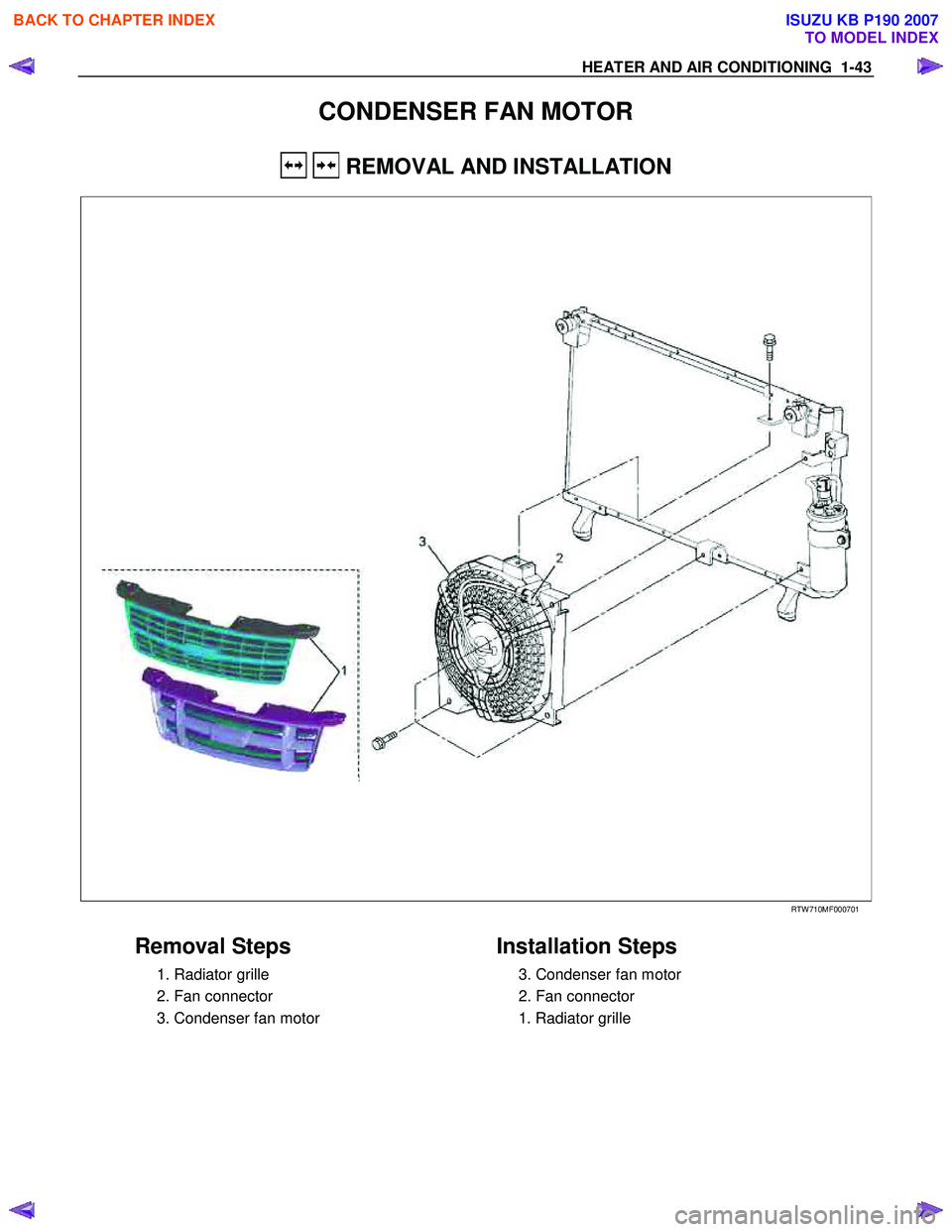
HEATER AND AIR CONDITIONING 1-43
CONDENSER FAN MOTOR
REMOVAL AND INSTALLATION
RTW 710MF000701
Removal Steps
1. Radiator grille
2. Fan connector
3. Condenser fan motor
Installation Steps
3. Condenser fan motor
2. Fan connector
1. Radiator grille
BACK TO CHAPTER INDEX
TO MODEL INDEX
ISUZU KB P190 2007
Page 78 of 6020
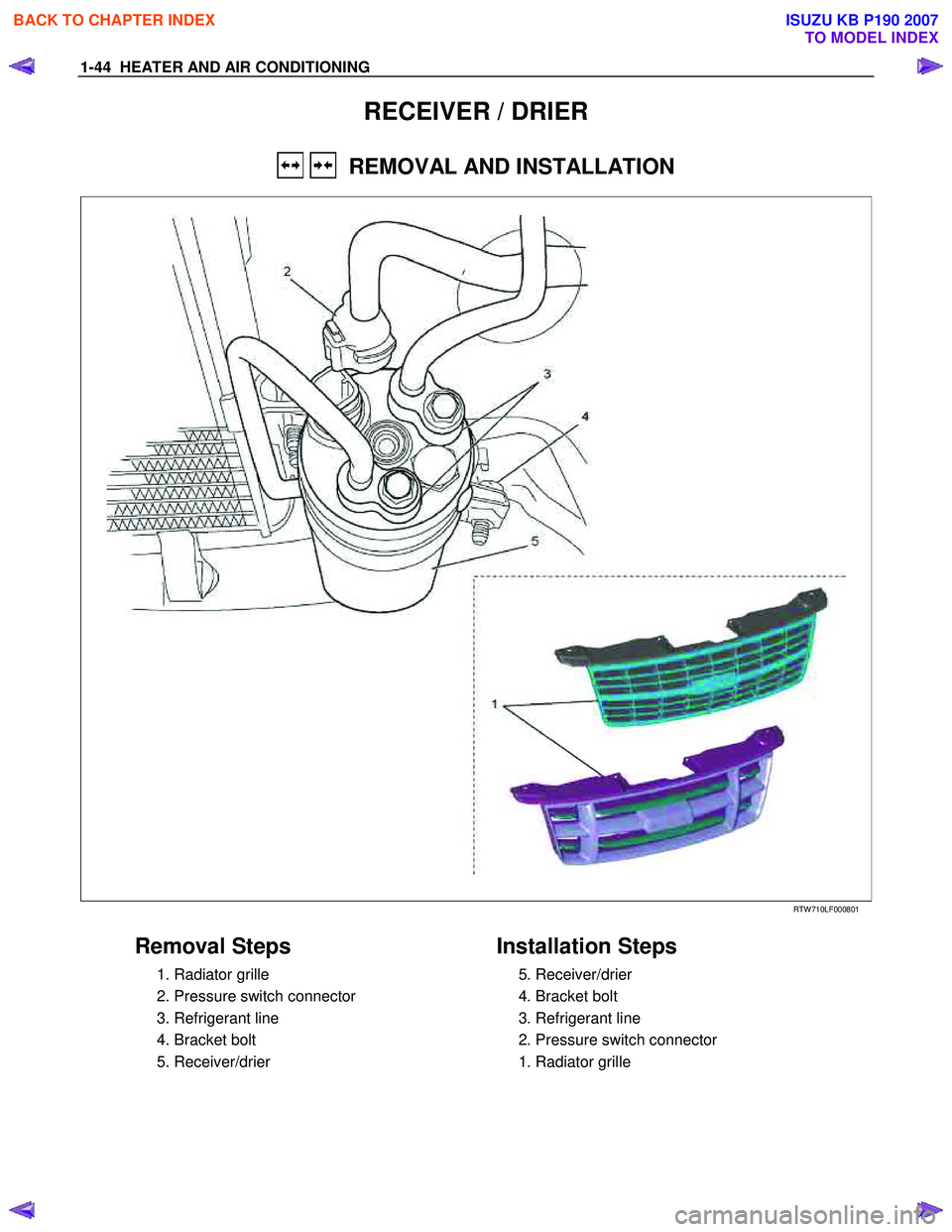
1-44 HEATER AND AIR CONDITIONING
RECEIVER / DRIER
REMOVAL AND INSTALLATION
RTW 710LF000801
Removal Steps
1. Radiator grille
2. Pressure switch connector
3. Refrigerant line
4. Bracket bolt
5. Receiver/drier
Installation Steps
5. Receiver/drier
4. Bracket bolt
3. Refrigerant line
2. Pressure switch connector
1. Radiator grille
BACK TO CHAPTER INDEX
TO MODEL INDEX
ISUZU KB P190 2007
Page 79 of 6020
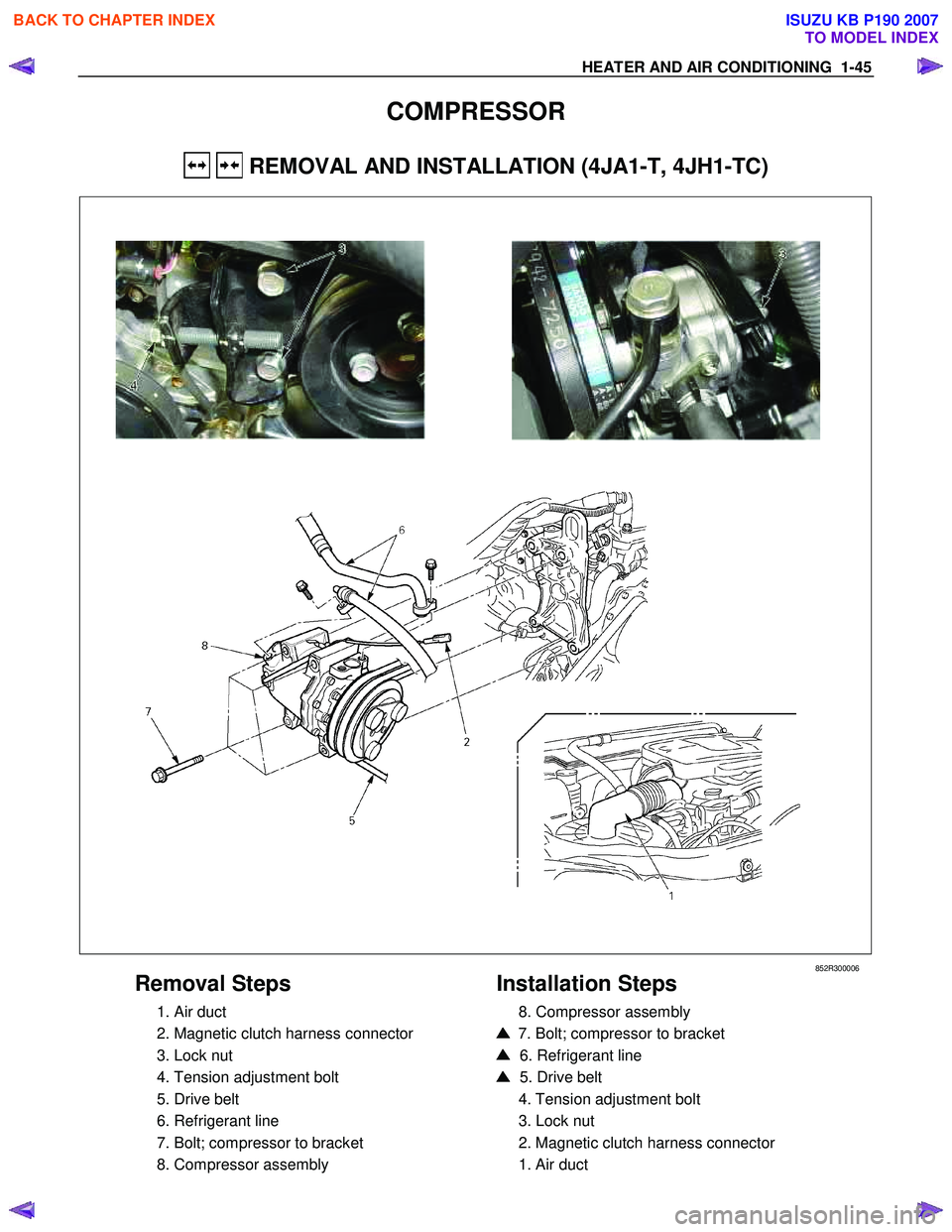
HEATER AND AIR CONDITIONING 1-45
COMPRESSOR
REMOVAL AND INSTALLATION (4JA1-T, 4JH1-TC)
852R300006
Removal Steps
1. Air duct
2. Magnetic clutch harness connector
3. Lock nut
4. Tension adjustment bolt
5. Drive belt
6. Refrigerant line
7. Bolt; compressor to bracket
8. Compressor assembly
Installation Steps
8. Compressor assembly
7. Bolt; compressor to bracket
6. Refrigerant line
5. Drive belt
4. Tension adjustment bolt
3. Lock nut
2. Magnetic clutch harness connector
1. Air duct
BACK TO CHAPTER INDEX
TO MODEL INDEX
ISUZU KB P190 2007
Page 80 of 6020

1-46 HEATER AND AIR CONDITIONING
Important Operations - Installation
7. Bolt; Compressor to Bracket
N⋅m (kgf ⋅m/lb ⋅ft)
Torque 44 (4.5/33)
6. Refrigerant Line
N⋅m (kgf ⋅m/lb ⋅in)
Torque 11 ∼19 (1.1/95 ∼1.9/168)
5. Drive Belt
Refer to SECTION 6A “COOLING SYSTEM”.
BACK TO CHAPTER INDEX
TO MODEL INDEX
ISUZU KB P190 2007